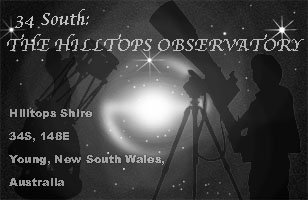KingClinton wrote: ↑Fri Mar 20, 2020 8:10 am
Cannot see it from down here.
But I have seen it mentioned on other social media platforms.
Sounds like it may pan out to be a good target.
Clinton,
Good view, post
perihelion, early June, pre-dawn from our latitude
!
Ephemeris from 35 south latitude
Source: NASA horizons
*******************************************************************************************************************************************
Date__(UT)__HR:MN R.A.(ICRF)_DEC T-mag N-mag delta deldot S-O-T /r S-T-O
*******************************************************************************************************************************************
2020-May-20 00:00 04 00 35.45 +44 00 15.9 -0.58 14.82 0.79042729535373 -8.4603509 24.1812 /T 107.7539
2020-May-25 00:00 03 42 21.55 +34 29 47.4 -3. 15. 0.78379351990336 6.4732460 14.6797 /L 127.3688
2020-May-30 00:00 03 37 01.22 +22 22 47.1 -5. 14. 0.84515723690074 37.8450990 11.8811 /L 125.1383
2020-Jun-04 00:00 03 52 51.34 +12 51 27.6 -4.00 13.77 0.98911716761748 56.6825746 16.3748 /L 86.8477
2020-Jun-09 00:00 04 17 27.78 +08 10 25.4 -0.85 13.95 1.15150684006976 54.3685258 19.3050 /L 60.0450
2020-Jun-14 00:00 04 40 43.67 +05 57 26.0 1.92 14.37 1.30082078399497 49.1288636 20.9882 /L 45.9078
2020-Jun-19 00:00 05 00 59.61 +04 45 46.9 4.12 14.80 1.43603595449908 44.6882352 22.1981 /L 37.7891
2020-Jun-24 00:00 05 18 34.39 +04 01 25.9 5.89 15.20 1.55961841734497 41.0212381 23.2420 /L 32.6676
2020-Jun-29 00:00 05 33 58.17 +03 30 06.2 7.36 15.56 1.67340027780479 37.8610265 24.2670 /L 29.2353
Column meaning:
TIME
Times PRIOR to 1962 are UT1, a mean-solar time closely related to the
prior but now-deprecated GMT. Times AFTER 1962 are in
UTC, the current
civil or "wall-clock" time-scale.
UTC is kept within 0.9 seconds of UT1
using integer leap-seconds for 1972 and later years.
Conversion from the internal Barycentric Dynamical Time (TDB) of solar
system dynamics to the non-uniform civil UT time-scale requested for output
has not been determined for
UTC times after the next July or January 1st.
Therefore, the last known leap-second is used as a constant over future
intervals.
Time tags refer to the UT time-scale conversion from TDB on Earth
regardless of observer location within the solar system, although clock
rates may differ due to the local gravity field and no analog to "UT"
may be defined for that location.
Any 'b' symbol in the 1st-column denotes a B.C. date. First-column blank
(" ") denotes an A.D. date. Calendar dates prior to 1582-Oct-15 are in the
Julian calendar system. Later calendar dates are in the Gregorian system.
NOTE: "n.a." in output means quantity "not available" at the print-time.
R.A._____(ICRF)_____DEC =
Astrometric right ascension and declination of the target center with
respect to the observing site (coordinate origin) in the reference frame of
the planetary ephemeris (ICRF). Compensated for down-leg light-time delay
aberration.
Units:
RA in hours-minutes-seconds of time (HH MM SS.
ff)
DEC in degrees-minutes-seconds of arc (sDD MN SC.f)
T-mag N-mag =
Comet's approximate apparent visual total magnitude ("T-mag") and nuclear
magnitude ("N-mag") by following standard
IAU definitions:
T-mag = M1 + 5*log10(delta) + k1*log10(r)
N-mag = M2 + 5*log10(delta) + k2*log10(r) + phcof*beta
Units: MAGNITUDES
delta deldot =
Range ("delta") and range-rate ("delta-dot") of target center with respect
to the observer at the instant light seen by the observer at print-time would
have left the target center (print-time minus down-leg light-time); the
distance traveled by a light ray emanating from the center of the target and
recorded by the observer at print-time. "deldot" is a projection of the
velocity vector along this ray, the light-time-corrected line-of-sight from
the coordinate center, and indicates relative motion. A positive "deldot"
means the target center is moving away from the observer (coordinate center).
A negative "deldot" means the target center is moving toward the observer.
Units:
AU and KM/S
S-O-T /r =
Sun-Observer-Target angle; target's apparent SOLAR ELONGATION seen from
the observer location at print-time. Angular units: DEGREES
The '/r' column indicates the target's apparent position relative to
the Sun in the observer's sky, as described below:
For an observing location on the surface of a rotating body
(considering its rotational sense):
/T indicates target TRAILS Sun (evening sky; rises and sets AFTER Sun)
/L indicates target LEADS Sun (morning sky; rises and sets BEFORE Sun)
For an observing point NOT on a rotating body (such as a spacecraft), the
"leading" and "trailing" condition is defined by the observer's
heliocentric orbital motion: if continuing in the observer's current
direction of heliocentric motion would encounter the target's apparent
longitude first, followed by the Sun's, the target LEADS the Sun as seen by
the observer. If the Sun's apparent longitude would be encountered first,
followed by the target's, the target TRAILS the Sun.
NOTE: The S-O-T solar elongation angle is numerically the minimum
separation angle of the Sun and target in the sky in any direction. It
does NOT indicate the amount of separation in the leading or trailing
directions, which are defined in the equator of a spherical coordinate
system.
S-T-O =
"S-T-O" is the Sun->Target->Observer angle; the interior vertex angle at
target center formed by a vector to the apparent center of the Sun at
reflection time on the target and the apparent vector to the observer at
print-time. Slightly different from true PHASE ANGLE (requestable separately)
at the few arcsecond level in that it includes stellar aberration on the
down-leg from target to observer. Units: DEGREES
Computations by ...
Solar System Dynamics Group, Horizons On-Line Ephemeris System
4800 Oak Grove Drive, Jet Propulsion Laboratory
Pasadena,
CA 91109 USA
Information:
http://ssd.jpl.nasa.gov/
Connect : telnet://ssd.jpl.nasa.gov:6775 (via browser)
telnet ssd.jpl.nasa.gov 6775 (via command-line)
Author :
Jon.D.Giorgini@jpl.nasa.gov











